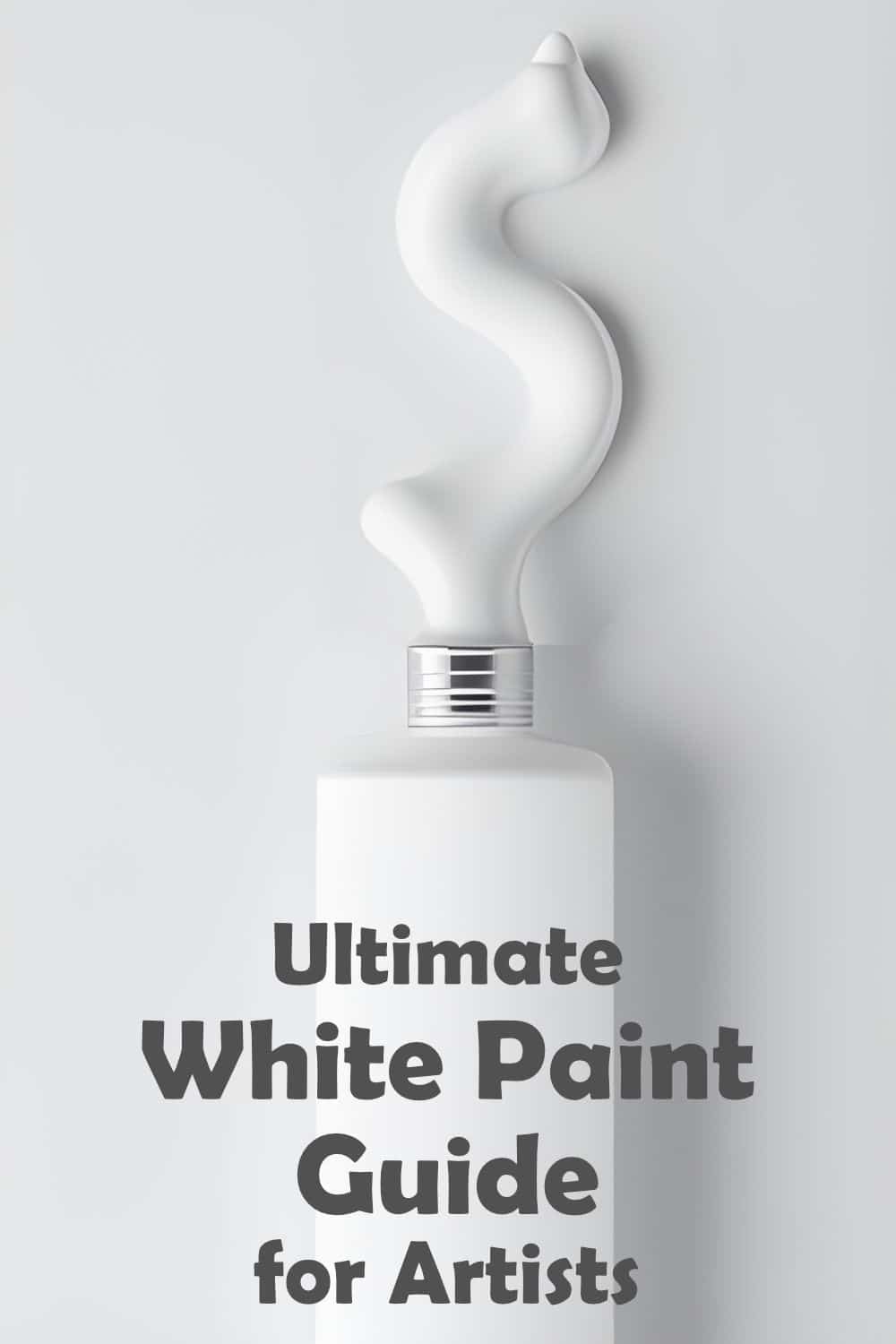Ultimate Guide
Dive into our ultimate guide on the best white paint choices for artists. We’re unpacking the world of whites, from types to opacity to texture, so you’ll know which is the right white for you in no time!
Scientifically, black and white are not true colours – black results from all colour wavelengths being absorbed and white from all wavelengths being reflected.
But humans don’t see scientifically but perceptually, and to artists especially, the opposites, black and white, are considered colours and important ones at that.
In this tutorial we will look at white paint.
History of White Paint
White is associated with – purity and innocence. Being the colour highest in value it creates a feeling of space and brightness
The earliest white pigments used in prehistoric times, were made from a mixture of powdered lime and gesso.
The ancient Greeks introduced lead white paint which was widely used during the Renaissance and is still used by some artists today but which is toxic.
When Titanium white came on the art scene relatively recently (1910’s), it became the go-to white for many artists as it was non-toxic.
What is white paint good for?
When asked what they use white for, “lightening and brightening colour” is usually the standard answer but it’s only partly true. Adding white paint to a colour does raise the value, (makes it lighter) but it doesn’t make the mix brighter.
Adding white cools down a colour and makes it less saturated (duller) – a washed out and dull chalky pastel version of the original colour. That fine if pastels are what you aiming for but if not, you’ll be disappointed.
This ability of white to cool and desaturate, (dull), a colour is used by landscape painters to create atmospheric perspective. Adding increasing amounts of white to the colour mix for objects that are further away, makes them appear to recede and gives the illusion of depth.
However, adding lots of white to a colour to make it brighter may have just the opposite effect.
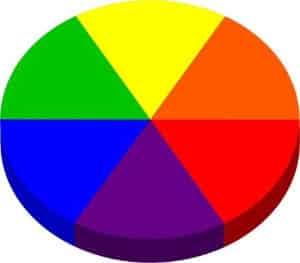
The trick to mixing lighter colours that don’t lose brightness, is to add some of the next colour up on the colour wheel towards yellow every time you add white to a mix to lighten it, which will brighten it as well. For example, if you want to lighten a green, and don’t want it to lose brightness, adding white will raise the value (lighten) and adding some yellow as well to the mix will brighten the colour. For a detailed explanation on how to lighten and brighten colours when mixing, you can view my Color Mixing Rules Tutorial.
White paint can’t be mixed from other colours, so we have to buy it. Fortunately, these days we have a wide range of whites to choose from to suit every need.
What makes one white different from another?
Examining the characteristics of white paint will help you decide which white to choose.
Opacity / Transparency.
How transparent (see through) or opaque (not see through), a particular white is, will affect how it’s best used.
An opaque white will have excellent covering power, totally blocking out any colour it’s painted over. A less opaque white will allow what’s underneath to show through.
If you want to create a misty, dusty or smoky effect, or tone down a too-vibrant colour by glazing white over it, a more transparent white is the obvious choice.
However, if you want solid coverage then go for the paint that has a high opacity. This is especially important when you start mixing colours for a painting and need to create the most dramatic colour shifts quickly. Later in the painting process you may want to refine colours by subtly lightening the value, then a more transparent white would be the best choice.
“The more opaque the white, the more expensive the paint”, is a general rule of thumb.
Tinting Strength
Tinting strength affects how much a colour will change other colours it is mixed with. If a small amount of paint mixed with a base colour makes a big colour change in the mix, then the paint is said to have a high tinting strength. If you must add lots of a colour to change the base colour, then the paint has a relatively low tinting strength.
Whites differ in their tinting strength. Whites with a high tinting strength are inclined to dominate less strong colours and overpower them. This can be seen in the washed-out pastel colours often created when mixing a colour with too much white.
Transparent colours when mixed with whites with high tinting strength, lose their translucency, which is why if you paint portraits, you may find a less opaque white with a lower tinting strength more suitable for capturing the translucency of skin tones in the final stages of the portrait than a very opaque titanium white with high tinting strength.
Similarly, landscape artists painting mist, dust or fog, which require only a slight shift in colour, would find a low-tinting white preferable. Whites with a low tinting strength are also useful for modifying light while still being able to see the layers below.
Drying Time
Acrylic artists don’t have to worry about this characteristic of white paint as all acrylic paints dry fast. For oil painters however, this is an important consideration.
Because of the fat over lean rule, you don’t want to apply a fast-drying paint over a slow-drying layer as cracking may result due to their different drying rates. This applies especially to oil painters that paint in layers and not alla prima. Information is available online on the drying rates of most good quality oil paints.
Oil paints made with linseed oil dry faster than those made with safflower or poppy oil.
You can speed up the drying time of oil paint by adding an alkyd medium – Galkyd or Liquin are examples.
Quick-drying white oil paints are made with an alkyd resin included. You can mix traditional oil paints with alkyd paints. By using a fast-drying white in mixing, the drying time of the entire painting will be sped up.

Temperature and Colour Bias
An artist needs to know if the white they are using has a warm bias, (tends towards yellow), a cool bias, (tends towards blue) or no bias in which case it is called a neutral white. When mixing paint this can make a difference to the end result, as all colours have a colour bias.
Whether a white oil paint is warm or cool will depend on the oil used to mix it. Safflower oil doesn’t yellow and is therefore used in oil whites that are considered cool. Linseed oil on the other hand, does yellow which imparts a warm bias.
Portrait artists often prefer a warm white, while landscape artists often opt for a cool white.
Both landscape and portrait artists tend to use white to add light to paintings when mixed with other colours and not as a stand-alone colour. Abstract and still life artists however, may use white as a colour in its own right, not mixed with other colours and need to be able to choose the temperature of the white they use.
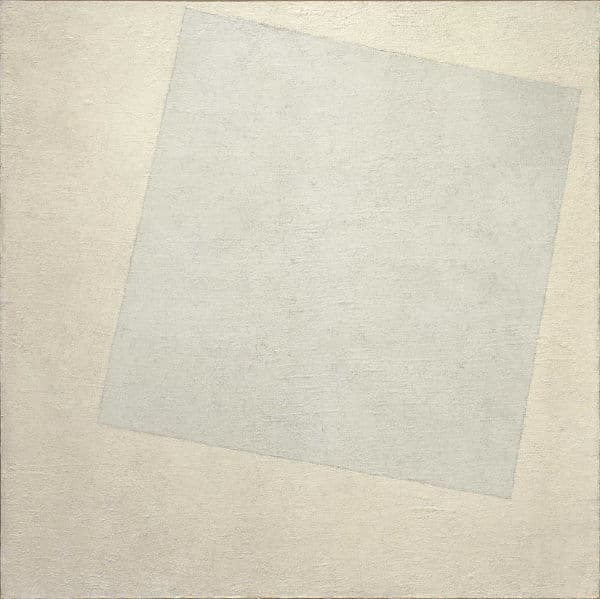
Tendency to Yellow
The oil used to make paint also affects how the white will behave over time. Some whites are prone to yellowing and if you want your whites to remain exactly the colour you originally laid down then a paint made using safflower oil not linseed oil, is a better choice as there is no colour shift over time in the former.
Texture
While the texture of a paint can be altered by adding mediums or thickening agents, it is good to know what the texture of a paint is straight out of the tube so you can choose the paint that will make it easier to create the effect you want.
Stiffer paints add physical texture to a painting as they retain brush strokes and can be used for impasto techniques.
Softer paints can be used straight from the tube and spread easily without the addition of mediums.
There are also those that fall between these two extremes.
Types of white paint commonly available
Although there are small differences between manufacturers, white paints fall into two broad categories, opaque or transparent to some degree.
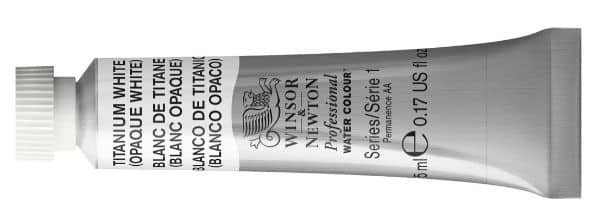
Titanium White (oil & acrylic)
Titanium white is the most widely used and best known of all the whites, both in oils and acrylics and the standard against which other whites are compared. It’s opaque with a high tinting strength.
It became available in the early 1910’s and is non-toxic, made from an oxide of titanium (titanium dioxide) – a naturally occurring mineral pigment derived from rocks.
The brightest of all the whites, it reflects 97% of the light that reaches it. It’s a favourite of impressionists who need strong highlights and with abstract painters for opaque colour passages.
Titanium white mixes well with most other colours but because of its opaqueness and high tinting strength, when mixed with transparent colours, they too become opaque. For this reason, it’s not ideal for glazing or scumbling and can reduce the vibrancy of paints it’s mixed with. (See above on how to overcome this problem).
Although the oil paint version is slow drying, an alkyd medium that promotes faster drying can be added to help reduce the drying time.
Some manufacturers offer a version of Titanium white oil paint which is made using linseed oil as the carrier oil. Linseed oil is fast-drying and therefore somewhat mitigates the slow drying characteristic of Titanium white.
There is a trade-off however and in this case it’s that linseed oil tends to yellow when it gets old. If using white paint straight out of the tube (i.e., not mixed with other colours), this could be a problem. It might then be better to opt for a Titanium white which is made using safflower oil which, while slow drying, doesn’t yellow over time. If used to mix into other colours, yellowing is not a problem.
You could use both types of Titanium white in one painting. The slower drying, but non-yellowing safflower-based paint can be used in the top layers and the quicker-drying but susceptible to yellowing white used in the bottom layers.
The temperature bias of titanium white will also depend on which carrier oil is used, so be sure to check the information on the tube. Safflower based paints tends to be neutral or slightly cool. Linseed-based will be slightly warmer.
Acrylic Titanium white, while slower drying than other acrylic colours, still dries fast. It’s possible to slow down the drying time by adding retarders.
Titanium White is the go-to choice for beginner artists because of its availability, high tinting strength, brightness, versatility and non-toxicity.

Antique White (oil & acrylic)
Antique white is also opaque but much less common than Titanium white. It can be found in some oil ranges, including the Winsor & Newton Oilbar.
Antique white has a warm colour bias and creates softer mixes than Titanium which is why it is a favourite of portrait painters.
It doesn’t yellow over time and contains no toxic lead.
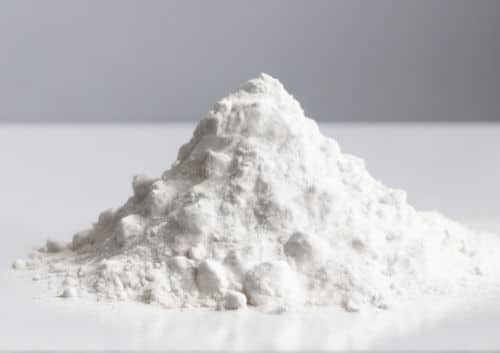
Zinc White (oil & acrylic)
Zinc white became popular from the 19th century onwards. It falls into the ‘more transparent whites’ category as it is the most transparent of all the white paints. It is often used and widely available.
Made from zinc oxide, a white powdery substance found in the mineral zincite, it’s safe to use as it contains no lead or other toxic substances. (Zinc oxide is also an ingredient of sunscreens).
Because it’s a semi-transparent white, it’s an excellent choice for mixing with other colours without overpowering them and ideal for glazing, scumbling, painting mist etc., or for creating diffused light effects.
Due to its low tinting strength, a significant amount must be added to achieve a noticeable change when lightening a base color into which it is mixed. This can be an advantage as it’s possible to make finer adjustments to a colour than when using titanium white which has a high tinting strength and very little paint added results in a big colour shift.
Due to its low opacity, Zinc white can be used to lighten transparent and semi-transparent colours without sacrificing all of their transparency.
It dries slowly but, because its semi-transparent, it is useful for underpainting as you can see a sketch on the canvas through it. Drying time can be sped up somewhat by adding an alkyd medium.
Again some Zinc white oil paint is made using safflower oil as a carrier which will dry more slowly than Zinc white produced with a linseed oil carrier.
Although Zinc white shares many characteristics with another popular white called Flake white (see below), Zinc white is cheaper and has the advantage of being non-toxic.
Straight out of the tube Zinc white has a stiff texture but it’s not good for use in impasto work because it gets brittle when dry and can crack when used in large amounts on a flexible surface like canvas. This is not a problem if painting on a rigid surface like board.
Because of this drawback, it is often not the go-to white used in painting but an excellent addition for more advanced artists because of its special characteristics.
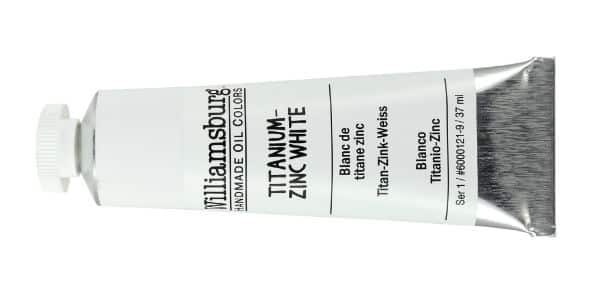
Titanium-Zinc White (oil)
Not as well-known as either Titanium or Zinc White, this paint combines the best of both – the covering power of Titanium white and the low tinting strength of Zinc white without the tendency to crack.
It is softer than Zinc white and brighter. It has greater covering power as it is slightly opaque but not as opaque as Titanium White, so it doesn’t overpower colours it is mixed with.
It makes an excellent all-purpose white.

Flake White (oils)
(Also called Lead White, Snowflake White or Chemnitz White)
Historically flake was the only white paint available to artists until the 19th Century when other types of white paint came into use.
Made from a synthetic inorganic pigment derived from lead, it’s extremely durable but also very toxic. In ancient times Flake white was commonly used as a base layer because of its durability.
Besides durability, it is sought after because it’s flexible, bright and doesn’t crack easily. It also dries relatively fast which is important when time is money.
Its texture straight out of the tube is stiffer than that of other whites and it has a warm colour bias making it very popular with portrait painters.
The traditional flake white formulation (called Flake White No 1), which contains lead mixed with zinc oxide, is still available. However, because of the toxicity of the lead it contains many artists avoid it. For others its benefits allowed them to overlook its drawbacks.
When mixed with other colours, the tints produced remain clean and pure, not washed out as is often the case when using Titanium white.
Flake white can darken when exposed to certain environmental conditions over time. This darkening is caused by chemical reactions with impurities or exposure to sulfur-containing compounds in the air. This is not a problem when making oil paint as the oil acts as a protective barrier between the pigment and the elements. This is not the case with acrylic paint where the water base evaporates. As a result Flake white is not available as an acrylic paint.
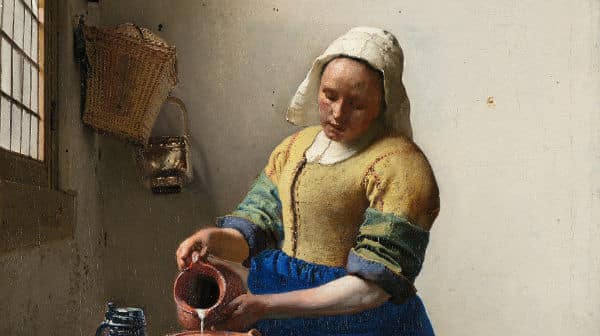
Flake White Hue (oils)
Produced by Winsor & Newton, it is a modern version of flake white which, because the pigment used is titanium and not lead, gets passed the toxic properties of traditional Flake White while still retaining the lower tinting strength.
It is made using linseed oil which gives it a fast drying-rate and a warm colour bias.
Flake White Hue is very useful for glazing, portraiture and figure painting because of its translucency.
It is available from Winsor & Newton in their student grade, Winton range as well as in artist quality.
In the painting above of The Milkmaid, Johannes Vermeer used Lead or Flake White to create a glow that could not be matched by other white paints.
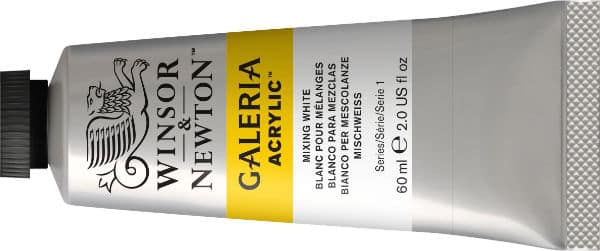
Mixing White (oil & acrylic)
Overall, Mixing white is very much the same as Zinc white. It also has a low tinting strength and is useful for glazes, tinting and for mixing with other colours.
Softer in texture than Titanium White, it dries fairly quickly and doesn’t yellow over time. It contains no lead, so it is safe for the environment and for the artist.
It is neutral in its colour bias tending neither to warm nor cool.
For experienced artists mixing white can be a useful addition to the palette.
It’s available from Winsor & Newton including their student (Winton) range of paints and their water mixable range (Artisan) as well as their alkyd range (Griffin)

Iridescent White (oil & acrylic)
This is a “special effects” paint which contains a mica-based pigment that gives it its pearlescent shimmer when used on its own and when mixed with other colours imparts this shimmer to them as well. It has the greatest effect when mixed into semi-transparent colours.
While white is bright and colourless, reflecting all visible light, iridescent white acts like a prism and reflects light broken up into the different colour bands depending on the angle at which the viewer views it.
Clearly this white is only for special effects and not as a go-to white.
Fast Drying Whites (alkyd paints)
As the name suggests these whites are specially formulated to dry within 24 hours which can be useful to the oil painter who prefers to wark in layers. They have a fast-drying alkyd medium included in their formulation.
They can be mixed with traditional colours and will speed up the drying time of the mixes as well in relation to how much of the fast-drying white was used.
They are thicker out of the tube than Titanium white and should be thinned with painting medium and not oils to retain their quick drying properties.
Because it’s thick, Alkyd white is useful for impasto layers which will also dry much faster than when traditional impasto paint is used.
Underpainting White
Used as an underpainting white, it helps to create an oil-based surface that makes oil paint applied on top more workable. This is especially so if you want to paint glazes perhaps in a grisaille method.
It’s possible to paint oils onto the semi-dry layer when painting alla prima.
Underpainting white can also be used to add texture to the painting surface with impasto layers which dry faster but must be allowed to dry completely before painting over them.
Influencing Color Harmony and Mood
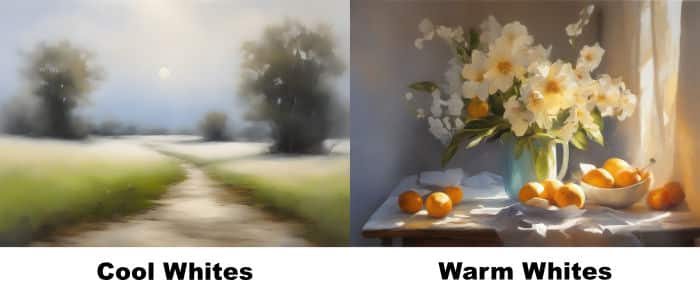
Choosing the right white paint isn’t just about texture, drying times, or yellowing tendencies; it also plays a significant role in defining the color harmony and mood of a painting.
Different whites carry distinct temperature biases that can subtly influence your color palette. A cooler white, such as Titanium White made with safflower oil, can infuse your painting with a fresh, bright, or distant feel, often suitable for seascapes or winter landscapes.
Conversely, warmer whites like Flake White or Antique White introduce a warm glow, imbuing the artwork with an intimate, nostalgic, or serene mood. These are particularly beneficial in portrait painting, where warmer skin tones are often desired, or in creating a late afternoon or sunset effect in landscape painting.
The key here is to remember that your choice of white can either enhance or diminish the emotional resonance of your artwork. So, consider not just the technical but also the emotional aspects of your choice of white. It’s these nuanced decisions that contribute to your unique artistic voice and make your artwork truly sing!
In Summary
There are many types of white paint at your disposal. For the beginner it’s probably best to simplify things by opting for Titanium White. As you progress on your painting journey you may find reason to use some of the other options to make the achievement of your desired outcome that much easier.
Pin Me
